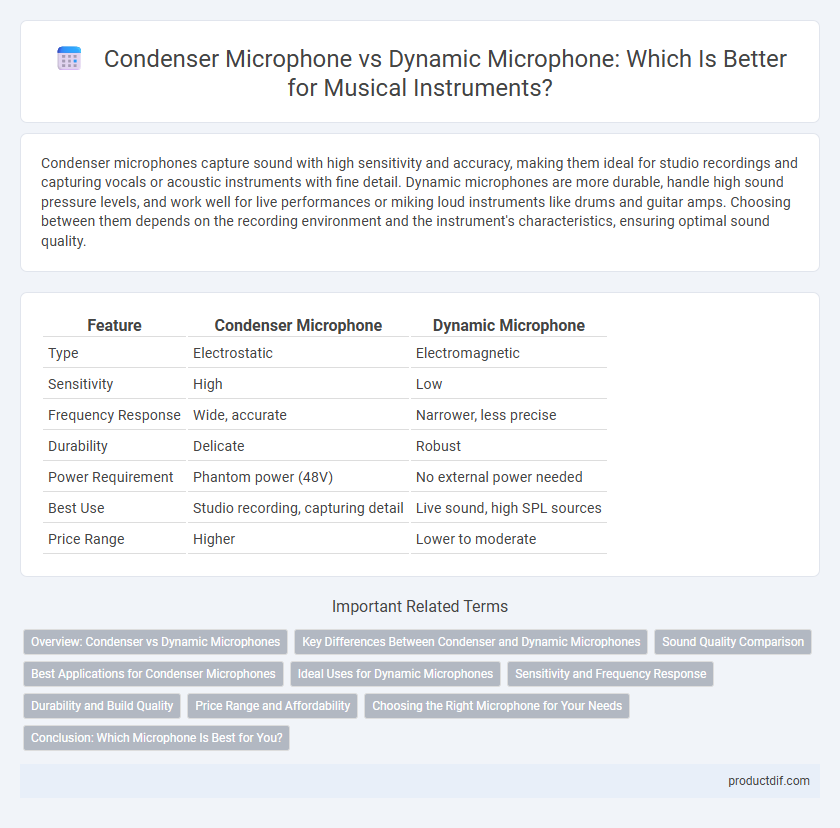Condenser microphones capture sound with high sensitivity and accuracy, making them ideal for studio recordings and capturing vocals or acoustic instruments with fine detail. Dynamic microphones are more durable, handle high sound pressure levels, and work well for live performances or miking loud instruments like drums and guitar amps. Choosing between them depends on the recording environment and the instrument's characteristics, ensuring optimal sound quality.
Table of Comparison
| Feature | Condenser Microphone | Dynamic Microphone |
|---|---|---|
| Type | Electrostatic | Electromagnetic |
| Sensitivity | High | Low |
| Frequency Response | Wide, accurate | Narrower, less precise |
| Durability | Delicate | Robust |
| Power Requirement | Phantom power (48V) | No external power needed |
| Best Use | Studio recording, capturing detail | Live sound, high SPL sources |
| Price Range | Higher | Lower to moderate |
Overview: Condenser vs Dynamic Microphones
Condenser microphones capture a wider frequency range and higher sensitivity, making them ideal for studio recordings and acoustic instruments. Dynamic microphones excel in durability and handling high sound pressure levels, preferred for live performances and loud sound sources like drums or guitar amps. Both types offer distinct advantages depending on the application, with condensers favoring clarity and dynamics suited for rugged environments.
Key Differences Between Condenser and Dynamic Microphones
Condenser microphones feature a lightweight diaphragm and require external power, providing a wider frequency response and greater sensitivity ideal for capturing vocals and acoustic instruments with precise detail. Dynamic microphones use a robust coil and magnet mechanism, offering durability and handling high sound pressure levels, making them suitable for live performances and loud sound sources like drums and guitar amps. The key differences lie in sensitivity, frequency response, power requirements, and application environments, impacting sound quality and instrument recording techniques.
Sound Quality Comparison
Condenser microphones capture a wider frequency range and deliver higher sensitivity, producing clearer and more detailed sound ideal for studio recording and vocals. Dynamic microphones are less sensitive but excel at handling high sound pressure levels, making them suitable for live performances and louder instruments with robust sound quality. When comparing sound quality, condenser mics provide crisp, accurate audio reproduction, while dynamic mics offer warmer tones with durability under high volume conditions.
Best Applications for Condenser Microphones
Condenser microphones excel in capturing detailed, high-frequency sounds with clarity and sensitivity, making them ideal for vocal recordings, acoustic instruments, and studio environments where subtle nuances are critical. Their lightweight diaphragm and wide frequency response enable precise reproduction of vocals, guitars, pianos, and orchestral instruments. These microphones perform best in controlled settings, avoiding high sound pressure levels typical in live performances where dynamic microphones are preferred.
Ideal Uses for Dynamic Microphones
Dynamic microphones excel in live performances and high sound pressure environments due to their durability and resistance to moisture. They are ideal for capturing loud sound sources like guitar amplifiers, drums, and vocals in concert settings. Their robust design makes them suitable for outdoor events and rough handling without compromising audio quality.
Sensitivity and Frequency Response
Condenser microphones exhibit higher sensitivity and a wider frequency response, capturing subtle nuances and detailed sound across 20 Hz to 20 kHz with clarity. Dynamic microphones offer lower sensitivity, making them ideal for handling high sound pressure levels without distortion, typically featuring a narrower frequency range focused on mid frequencies around 50 Hz to 15 kHz. Sensitivity and frequency response differences determine the best microphone choice for studio recording or live performances, depending on sound source and environment.
Durability and Build Quality
Condenser microphones feature delicate diaphragms and sensitive internal components, requiring careful handling and generally offering less durability in rugged environments. Dynamic microphones are built with robust coils and diaphragms, making them highly resistant to physical shocks, moisture, and extreme conditions, ideal for live performances and touring. The solid construction of dynamic mics ensures long-term reliability, whereas condenser microphones demand protective measures to maintain optimal functionality.
Price Range and Affordability
Condenser microphones generally have a higher price range, often starting around $100 and reaching upwards of $2,000, due to their sensitive components and superior sound quality. Dynamic microphones are typically more affordable, with many models available between $50 and $200, making them accessible for beginners and budget-conscious musicians. Choosing between these types depends on balancing budget constraints with the desired audio fidelity for specific recording or live performance needs.
Choosing the Right Microphone for Your Needs
Condenser microphones capture high-frequency detail and are ideal for studio recording, vocals, and acoustic instruments due to their sensitivity and wide frequency response. Dynamic microphones are durable, handle high sound pressure levels, and excel in live performances and capturing loud sources like drums and guitar amplifiers. Selecting the right microphone depends on the recording environment, sound source, and desired audio quality, with condenser mics favored for clarity and dynamic mics preferred for robustness.
Conclusion: Which Microphone Is Best for You?
Choosing between a condenser microphone and a dynamic microphone depends on your specific recording needs and environment. Condenser microphones excel in capturing detailed, high-frequency sounds, making them ideal for studio vocals and acoustic instruments, while dynamic microphones are more durable and handle high sound pressure levels well, perfect for live performances and louder sources like drums or guitar amps. Assessing your setting, budget, and sound quality preferences will help determine the best microphone for your musical instrument recording setup.
Condenser Microphone vs Dynamic Microphone Infographic

 productdif.com
productdif.com